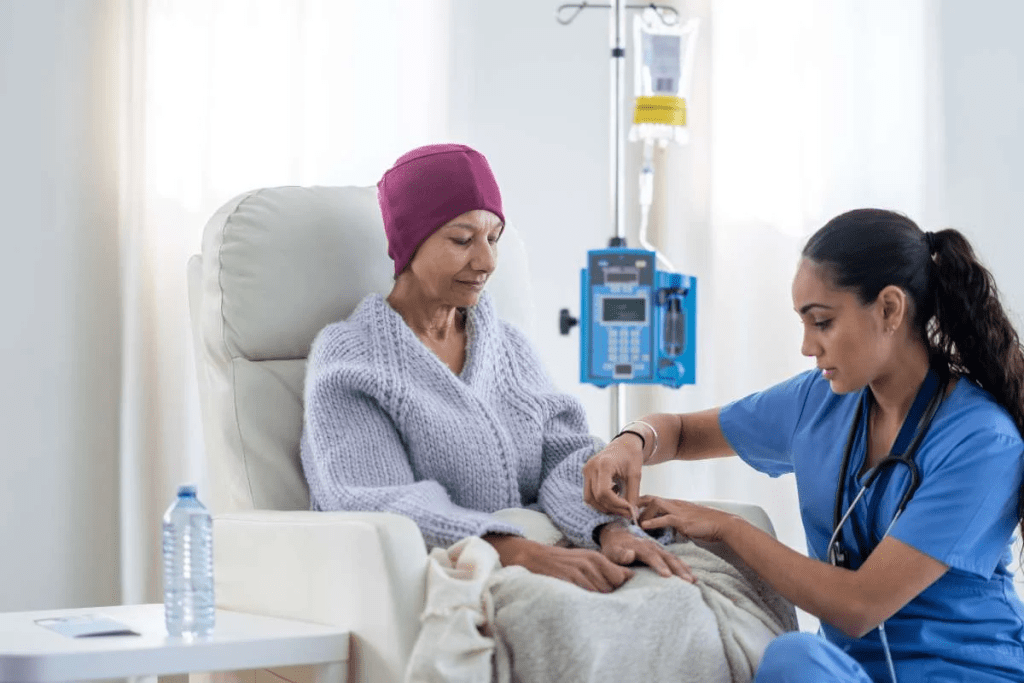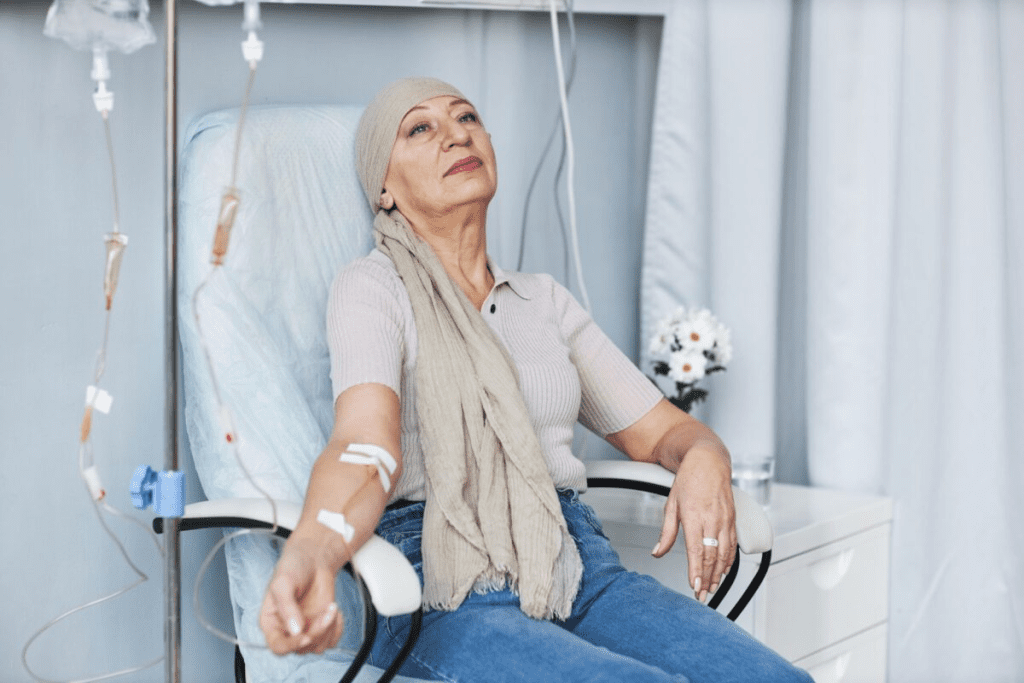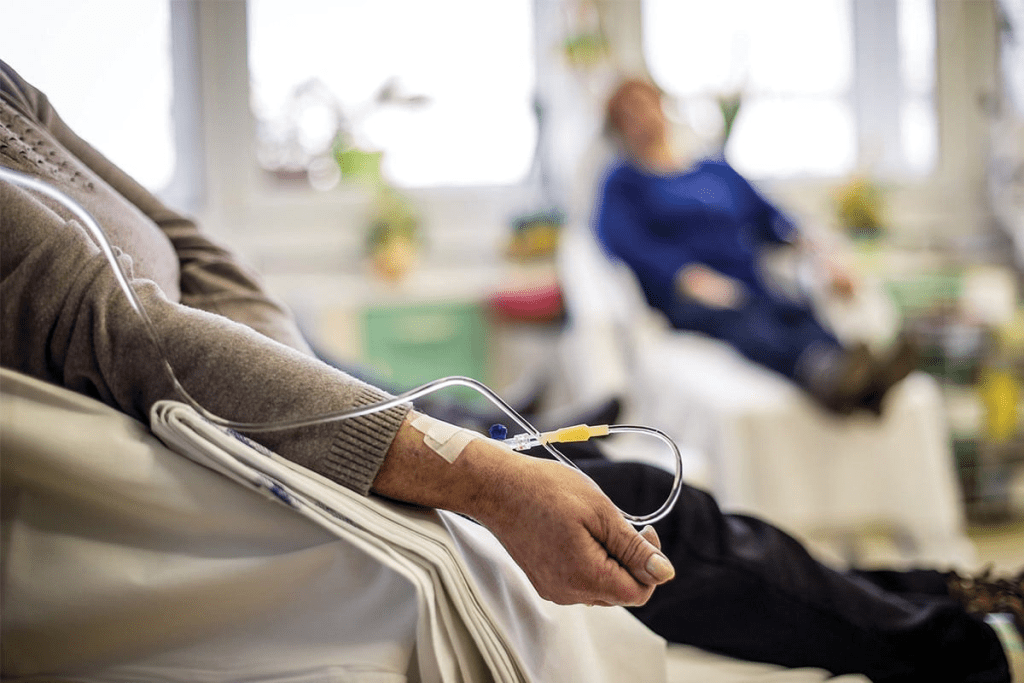Last Updated on November 26, 2025 by Bilal Hasdemir

Going through chemotherapy is tough for patients. One important part of the process is the chemotherapy 7 day break ” a common schedule used to balance treatment and recovery.
The chemotherapy 7 day break means receiving treatment for a set period (often one day or a few consecutive days), followed by seven days of rest. This rest phase allows the body to recover from the intense effects of chemo, especially on healthy cells like those in the bone marrow and digestive system.
This treatment-rest cycle is essential for the effectiveness of chemotherapy. It gives the body time to rebuild, lowers the risk of severe side effects, and helps patients stay strong throughout the full course of treatment.
Understanding the chemotherapy 7 day break helps patients know what to expect and how to prepare. It also allows for better planning of nutrition, rest, and support during both treatment and recovery days.
Key Takeaways
- The 7-day rule is a guideline used in chemotherapy treatment.
- It involves a cycle of treatment followed by rest days.
- The rule helps balance cancer cell killing and body recovery.
- Understanding the 7-day rule can help patients prepare for treatment.
- It is crucial for managing expectations and minimizing side effects.
The Fundamentals of Chemotherapy Treatment Cycles

Chemotherapy treatment cycles are key in fighting cancer. They help target cancer cells effectively. These cycles are designed to kill cancer cells while letting the body recover.
We use cycles to balance killing cancer cells with letting the body heal. This approach is crucial for treatment success.
Basic Principles of Chemotherapy Administration
Chemotherapy is based on several important principles. First, we choose chemotherapy drugs based on the cancer type. The dosage and schedule depend on the patient’s health, cancer stage, and treatment protocol.
Chemotherapy cycles include a treatment period followed by a rest period. This cycle may repeat several times, based on the treatment plan. The rest period is vital for the body to recover and rebuild healthy cells.
Why Treatment Schedules Matter
Treatment schedules are vital for chemotherapy’s success. Following the scheduled treatment plan helps target cancer cells well. It also reduces the risk of chemotherapy drug resistance.
Also, treatment schedules help manage chemotherapy side effects. By giving the body time to recover between cycles, we lessen side effects. This improves the patient’s quality of life during treatment.
Understanding the Chemotherapy 7 Day Break
The 7-day break between chemotherapy sessions allows the body time to recover and restore healthy cells. It’s key for patients getting chemotherapy. This time, let their bodies heal from the treatment’s impact.
Definition and Origin of the Rule
The 7-day rule for chemotherapy comes from how it affects cells. Chemotherapy targets cells that grow fast, like cancer cells and some healthy cells. These include cells in the bone marrow and the gut lining.
This break lets the body replace these cells and recover from chemotherapy’s damage. It’s vital for treating cancer without harming the patient too much.
Historical Development in Oncology Practice
The 7-day rule’s history is linked to learning about cell cycles and chemotherapy’s effects. Early chemotherapy was very intense and caused a lot of side effects. Researchers looked for ways to reduce these effects while keeping treatment effective.
- They noticed healthy cells recover faster than cancer cells. This led to treatment schedules that allow for recovery.
- Studies on cell cycles showed that different cells need different recovery times. This influenced when to give chemotherapy.
- Adding the 7-day break to chemotherapy plans has become common. It shows a balance between treatment strength and patient safety.
Understanding the 7-day break in chemotherapy helps us see the complexity of cancer treatment. It shows the effort to make treatment better for patients.
Medical Science Behind the 7 Day Rule
The 7-day gap between chemotherapy sessions is not random. It’s based on how our bodies naturally recover and the need to reduce harm. Chemotherapy attacks fast-growing cancer cells but also harms healthy cells. This makes the recovery time very important.
Cell Cycle Recovery Principles
Chemotherapy messes with the cell cycle, hurting both cancer and healthy cells. The 7-day rule helps these cells recover, especially in the bone marrow and gut. These areas are very sensitive to chemotherapy.
The cell cycle has phases like G1, S, G2, and M. Chemotherapy targets cells in different phases, especially when DNA is being made. Knowing how the cell cycle works helps doctors plan treatments better.
Key aspects of cell cycle recovery include:
- Regeneration of bone marrow cells
- Repair of damaged DNA
- Replenishment of immune cells
Protection of Healthy Tissues
The 7-day rule is also key for keeping healthy tissues safe from chemotherapy’s harm. It helps avoid severe side effects and long-term damage.
Healthy tissues that are especially at risk include:
- Bone marrow
- Gastrointestinal mucosa
- Hair follicles
Understanding the 7-day rule shows the careful balance between fighting cancer and keeping our bodies healthy.
How the 7 Day Rule Affects Different Treatment Protocols
It’s key to know how the 7-day rule affects cancer treatment plans. This rule is a big part of how chemotherapy is given out. It shapes how treatments are set up and given.
Standard Chemotherapy Cycles
Standard chemotherapy cycles follow the 7-day rule for recovery. This break is vital for the body to heal and handle chemotherapy side effects.
Different chemotherapy plans might change how often and for how long treatment is given. For example, some plans might give chemotherapy on day one, then wait 7 days before starting again.
| Chemotherapy Cycle | Day 1 | Day 7 | Day 14 | Day 21 |
| Cycle 1 | Chemotherapy | Rest | Chemotherapy | Rest |
| Cycle 2 | Chemotherapy | Rest | Chemotherapy | Rest |
Integration into Comprehensive Treatment Plans
The 7-day rule is part of a bigger treatment plan to make chemotherapy work well. It also helps keep side effects down and supports the patient’s health. This planning needs teamwork from the healthcare team.
When adding the 7-day rule to plans, we look at many things. These include the cancer type, the patient’s health, and the chemotherapy used. This way, we make treatment fit each patient’s needs.
Using the 7-day rule well in chemotherapy plans needs teamwork. Oncologists, nurses, and others work together. This team effort makes sure patients get care that meets their medical, emotional, and practical needs.
Safety Guidelines During the Chemotherapy 7 Day Break

Keeping safe during the 7-day chemotherapy break is key to your health. This time, let your body heal from chemotherapy’s effects. Following safety tips can reduce risks and manage side effects well.
Infection Prevention Measures
Preventing infections is very important during this break. Chemotherapy can make your immune system weaker. Here are some steps to take:
- Practice good hygiene by washing your hands frequently, especially before eating and after using the bathroom.
- Avoid close contact with people who are sick.
- Stay away from crowded areas and avoid large gatherings.
Activity Restrictions and Recommendations
Rest is important, but some activities are okay or needed. Here are some guidelines:
- Light Exercise: Gentle activities like short walks can be beneficial for circulation and mood.
- Rest: Ensure you get plenty of rest to help your body recover.
- Avoid Strenuous Activities: Refrain from heavy lifting, bending, or any activity that could cause injury or strain.
When to Contact Your Healthcare Provider
Knowing when to get medical help is important. Call your healthcare provider if you have:
- Fever above 100.4 °F (38 °C)
- Signs of infection, such as chills, cough, or sore throat
- Unusual bleeding or bruising
- Severe fatigue or weakness
Here’s a summary of key safety guidelines in the table below:
| Guideline | Description |
| Infection Prevention | Practice good hygiene, avoid sick individuals, and stay away from crowded areas. |
| Activity Level | Engage in light exercise, rest adequately, and avoid strenuous activities. |
| Monitoring Health | Watch for signs of infection, unusual bleeding, or severe fatigue. |
The Body’s Recovery Process During the 7-Day Period
When you take a 7-day break from chemotherapy, your body starts a complex healing process. This is a key time for patients to recover from chemotherapy’s side effects.
Recovery Timeline – Knowing how your body recovers is important for good care. We’ll look at how different parts of your body heal in these 7 days.
Immune System Rebuilding Timeline
Chemotherapy hits your immune system hard. During the 7-day break, your body starts to make more immune cells. This is key to fighting infections and staying healthy.
Blood Cell Count Regeneration
Chemotherapy can lower blood cell counts. The 7-day break lets your bone marrow make new cells. This helps prevent anemia, infections, and bleeding.
Organ Function Restoration
Organs like the liver and kidneys can be affected by chemotherapy. In the 7-day break, they start to work better. This is important for getting rid of drugs and toxins.
The 7-day chemotherapy break is a crucial part of treatment. It lets your body heal and rebuild. Understanding this process helps patients manage their health better and work with doctors for the best results.
Variations of the 7 Day 7 Rule Across Cancer Types
The 7-day rule in chemotherapy changes a lot for different cancers. This is because each cancer acts differently to treatment. Also, each patient has unique needs.
Solid Tumor Protocols
For solid tumors, the 7-day rule changes based on the tumor’s size and location. Neoadjuvant chemotherapy might need to adjust this rule. This ensures the tumor shrinks before surgery.
In breast cancer, chemotherapy timing depends on the tumor’s receptors and the patient’s health. The 7-day rule helps plan treatment. It allows for recovery and reduces side effects.
Blood Cancer Considerations
Blood cancers like leukemia and lymphoma need different chemotherapy plans. The 7-day rule changes based on blood cell counts and cancer aggressiveness.
In acute leukemia, chemotherapy might be more intense. The 7-day break could change based on how the patient responds and recovers. Supportive care is key during this time. It helps manage side effects and prevent infections.
Pediatric Cancer Adaptations
Pediatric cancer treatments are very specific. The 7-day rule is adjusted for the child’s age, weight, and cancer type. Children’s bodies are strong but need careful treatment to avoid long-term harm.
In pediatric leukemia, treatment plans are made based on the child’s response. The 7-day guideline is adjusted accordingly. Collaborative care from pediatric oncologists, nurses, and support staff is vital. It helps manage treatment and side effects.
It’s important for patients and doctors to understand these variations. By tailoring the 7-day rule to each cancer and treatment, we can improve care and outcomes.
Patient Experience During the Chemotherapy 7 Day Break
It’s important to know how patients feel during the 7-day chemotherapy break. This time can be tough, with both physical and emotional challenges. We need to help manage these well.
Common Physical Experiences
Patients may face several physical side effects during this break. These include:
- Fatigue: Feeling very tired or weak, which can make daily tasks hard.
- Nausea and Vomiting: Some may still feel sick or throw up, depending on their treatment.
- Hair Loss: Losing hair due to chemotherapy can be upsetting, affecting them during this time.
- Increased Risk of Infection: With fewer white blood cells, patients are more likely to get sick.
It’s key for patients to watch their health closely and tell their doctor about any bad symptoms.
Emotional and Psychological Aspects
The emotional and mental effects of the 7-day break are also important. Patients might feel:
- Anxiety: Concerns about the next treatment, side effects, and treatment success.
- Depression: Feeling sad or hopeless, made worse by chemotherapy’s side effects.
- Support System: Having a strong support network, like family and friends, is vital.
Emotional support is a big part of caring for patients during this tough time.
Practical Management Tips
To get through the 7-day break, patients can try these tips:
- Stay Hydrated: Drinking lots of water can help with some side effects.
- Rest: Resting well is key to recovery.
- Nutrition: Eating a balanced diet helps the body recover.
- Monitor Health: Keep track of side effects and tell the doctor.
Understanding these aspects helps us support patients better during the 7-day chemotherapy break.
When the 7 Day Rule Might Be Modified
The 7-day rule is common, but it can change in some cases. This change depends on the cancer type, the patient’s health, and the chemotherapy plan.
Dose-Dense Chemotherapy Approaches
Dose-dense chemotherapy means treatments are closer together, often less than 7 days. This is used for fast-growing cancers or when a quick response is needed. It’s chosen when the benefits are greater than the risks, and the patient can be closely watched.
Deciding on dose-dense chemotherapy is complex. It involves looking at the patient’s health and how well they can recover. It’s important to watch for side effects and adjust the treatment as needed.
Emergency Situations
In emergencies, like severe side effects or unexpected problems, the 7-day rule might be changed. Emergency situations require quick action and might mean changing the treatment schedule to keep the patient safe.
We look at each emergency case carefully. We consider how serious the issue is and how it affects the treatment plan. The aim is to balance effective cancer treatment with protecting the patient’s health.
Individual Patient Factors
Each patient’s situation is unique when it comes to the 7-day rule. Age, health, and other medical conditions are important. Personalized treatment plans are key to the best results.
We consider many factors when deciding to change the 7-day rule. This approach helps tailor the treatment to each patient’s needs, making care more effective.
The Role of Blood Tests in Determining Treatment Timing
Regular blood tests are key to checking if a patient is ready for the next chemotherapy session. These tests show the patient’s health status. This helps oncologists decide when to start treatment.
Before starting chemotherapy, oncologists check several important things. Key blood count parameters include:
- White Blood Cell (WBC) count: shows the risk of infection
- Absolute Neutrophil Count (ANC): important for checking neutropenia risk
- Platelet count: helps assess bleeding risk
- Hemoglobin levels: show if blood transfusions are needed
Key Blood Count Parameters
Blood tests check important parts to see if it’s safe to start chemotherapy. For example, a low WBC count means a higher risk of getting sick. This might make oncologists wait before starting treatment.
Decision-Making Process for Treatment Continuation
Deciding to keep going with chemotherapy involves looking at blood test results and the patient’s health. Oncologists also think about how well the patient has done with past treatments and the risks of more therapy. As one oncologist said,
“Blood tests are a critical tool in our decision-making process, allowing us to balance the benefits of treatment with the potential risks to the patient.”
By looking at blood test results and other important factors, oncologists can make smart choices about when to start treatment. This ensures patients get the best care they can.
Managing Side Effects During the 7-Day Recovery Period
Learning how to handle side effects during the 7-day recovery period can really improve a patient’s life. It’s about using medical advice and personal care tips together.
Medication Management Strategies
Managing medications correctly is key during recovery. Patients must follow their doctor’s orders for medications. This might include drugs for nausea, pain, or other needs. It’s important to know why you’re taking each medicine and any possible side effects.
Keeping a log of your medications and any side effects is a good idea. It helps spot patterns and adjust your treatment if needed.
Supportive Care Options
Supportive care is very important for dealing with chemotherapy side effects. This might mean drinking more water and eating foods that are easy to digest. Nutritional counseling can help make a diet plan that’s right for you.
Also, emotional support from loved ones or support groups is crucial. Doing relaxing things like meditation or gentle exercise can help with stress and discomfort.
Self-Care Techniques
Self-care is a big part of getting better. Using deep breathing exercises, progressive muscle relaxation, and guided imagery can help with stress and side effects like nausea and tiredness.
It’s also key to listen to your body and rest when you need to. Avoiding hard activities and getting enough sleep are important for healing. Adding these self-care steps to your daily life can help manage side effects and improve your recovery.
Communicating with Your Oncology Team About Treatment Schedules
Good communication with your oncology team is key to a smooth treatment process. It helps you understand your treatment schedules and manage side effects. This way, you’re ready for each step of your treatment.
Important Questions to Ask
When you talk to your oncology team, ask the right questions. Here are some important ones:
- What are the specific details of my treatment schedule?
- How might my treatment plan be adjusted based on my response?
- What are the potential side effects of my treatment, and how can they be managed?
- Are there any specific activities or precautions I should take during my treatment breaks?
- How can I contact my oncology team if I have concerns or questions between treatments?
These questions help you understand your treatment better. They also help you make informed decisions about your care.
Reporting Concerns During the Break Period
It’s important to tell your oncology team about any concerns or side effects during breaks. This includes:
- Any unusual symptoms or side effects
- Changes in your overall health or well-being
- Difficulty managing your treatment schedule
Your oncology team is there to support you. By keeping them informed, you get the help you need quickly.
Preparing for Your Next Treatment
As your next treatment gets closer, here’s what you can do to prepare:
- Review your treatment schedule and plan accordingly
- Arrange for transportation to and from your treatment sessions
- Bring a list of questions or concerns to discuss with your oncology team
- Have a support person accompany you to your appointments, if possible
Being proactive and talking well with your oncology team makes your treatment smoother. It also leads to better results.
Conclusion
The 7-day rule is key in chemotherapy treatment. It lets the body recover while fighting cancer cells. We’ve looked at why this break is important in oncology, its medical reasons, and how it varies by cancer type and treatment.
For patients getting cancer treatment, knowing about the 7-day break is vital. It affects their care and recovery. This rule helps balance killing cancer cells with letting the body heal, which is crucial in treatment plans.
Things like the cancer type, treatment plans, and patient needs can change how the 7-day rule is used. It’s important to talk well with oncology teams and follow safety rules during this time. This helps get the best treatment results.
In short, the chemotherapy 7-day break is a big part of cancer treatment. It needs careful thought and handling. By understanding it, patients and doctors can work together to get the best care in oncology.
FAQ
What is the 7-day rule in chemotherapy?
The 7-day rule in chemotherapy means a 7-day break between treatments. This break helps the body recover and allows healthy cells to grow back.
Why is the 7-day break important in chemotherapy treatment?
The 7-day break helps the body heal from chemotherapy’s toxic effects. It also lowers the risk of infection and helps the bone marrow make new blood cells.
How does the 7-day rule affect different chemotherapy treatment protocols?
The 7-day rule can change based on the cancer type and treatment plan. Some treatments might have shorter or longer breaks.
What are the safety guidelines during the chemotherapy 7-day break?
Patients should wash hands often and avoid sick people. They should also check their temperature and follow their doctor’s activity advice.
How does the body recover during the 7-day period after chemotherapy?
The body starts to heal by rebuilding the immune system and regenerating blood cells. The recovery speed varies based on the individual and the chemotherapy type.
Can the 7-day rule be modified, and if so, under what circumstances?
Yes, the 7-day rule can change in some cases. This includes dose-dense chemotherapy, emergencies, or treatment based on the patient’s needs. The oncologist decides these changes.
What is the role of blood tests in determining treatment timing?
Blood tests are key in deciding when to start the next treatment. They check blood counts to ensure it’s safe to proceed.
How can patients manage side effects during the 7-day recovery period?
Patients can manage side effects by following their medication plan and using supportive care. They should also eat well, stay hydrated, and rest enough.
Why is it important to communicate with the oncology team about treatment schedules?
Talking to the oncology team is crucial for the best care. Patients should ask questions, report concerns, and discuss their next treatment with their oncologist.
How does the 7-day rule vary across different cancer types?
The 7-day rule varies by cancer type, including solid tumors and blood cancers. Treatments are tailored to each patient’s needs.
References
- Motzer, R. J., Lin, H. Y., & Trump, D. (1990). The effect of a 7-day delay in chemotherapy cycles on good-risk germ cell tumor patients. Journal of Clinical Oncology, 8(5), 768“772. https://pubmed.ncbi.nlm.nih.gov/1696846/






